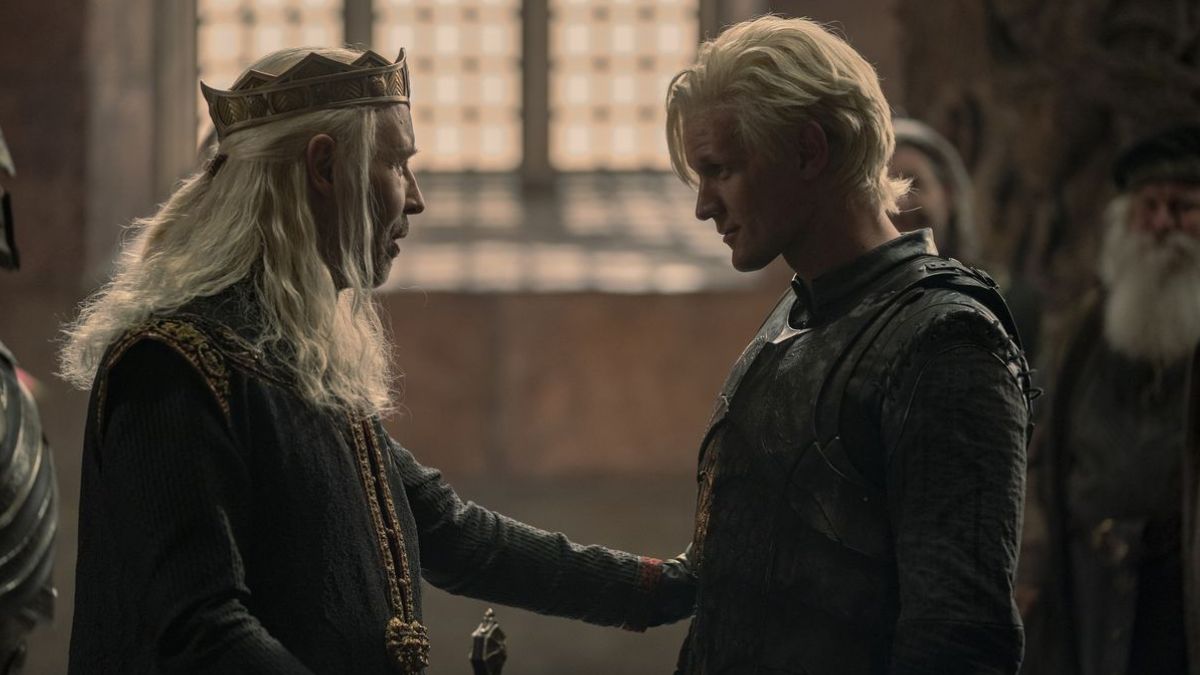The Latest Targaryen To Be Name-Dropped in ‘House of the Dragon’ Is Actually Pretty Important
We wouldn’t have several characters without him.

The third episode of the second season of House of the Dragon, “The Burning Mill,” continues the incredible character work that started with the pilot and especially with episode two.
It also confirms that this whole affair is nothing but a love letter from the showrunners to A Feast for Crows, the second to last of the ASOIAF books currently published and also one of the best. What can I say except “understandable”?
Spoilers ahead for the events of “The Burning Mill” as well as some lore notions from Fire & Blood, taking place before the start of the House of the Dragon timeline.
Just like the past two episodes, “The Burning Mill” also introduces us to a character that is seemingly an extra of little importance—even though the fact that they’re given screen time helps us immediately realize that’s not the case. We had actually already seen Ulf the White in this season’s second episode, but this time we get to hear him brag about his birth to some friends of his in one of King’s Landing’s most morally dubious establishments.
And it’s not an insignificant birth, either. If what Ulf says it’s true—which is very debatable—he would be none other than the bastard son of Baelon Targaryen, known to the people as Baelon the Brave, which would make him very closely related to some of our main players.
So who is Baelon the Brave in House of the Dragon?
Prince Baelon Targaryen was the fourth child of King Jaehaerys I and his sister-wife, the Good Queen Alysanne. Dubbed “the Spring Prince” because his birth had happened just a couple of days after the Citadel had officially announced the arrival of spring, he was named after the Targaryen Lord of Dragonstone before Aegon and his sisters embarked on the conquest of the Seven Kingdoms.
A brave and spirited Prince, Baelon was particularly close to his elder brother Aemon, and the two were known to go everywhere together. Baelon became a knight at sixteen, when he entered a tourney as a mystery knight and unhorsed many of the best jousters in the realm. That same year he also became a dragon rider, claiming the fearsome dragon Vhagar. He was her second rider after Queen Visenya, and the second of four total—we have met the other two, Lady Laena Velaryon and Prince Aemond Targaryen, in House of the Dragon.
Like most Targaryens, Baelon married his younger sister Alyssa, the child that Jaehaerys and Alysanne had after him. Alyssa was known throughout the realm to be fierce and strong, even though many commented on her not possessing the typical Targaryen features. Her hair was blonde instead of silver-white and she also had heterochromia, with one eye violet and the other green. She had a dragon as well, of course—in fact, she was the first rider of the she-dragon Meleys, the Red Queen.
Baelon and Alyssa had a total of three children, two of which we know very well—Princes Viserys, Daemon, and Aegon. Aegon’s birth, however, was difficult, and both child and mother died in less than a year. Baelon, whom histories say loved her immensely, always honored her memory and refused to remarry.
After his older brother Aemon was killed on Tarth, Jaehaerys named Baelon the Prince of Dragonstone in his place. The move greatly angered Queen Alysanne, who believed the throne should pass onto Aemon’s only child—another familiar character since it’s none other than Princess Rhaenys Targaryen. However, Baelon’s tenure as Prince of Dragonstone was short-lived. Some nine years later, Baelon died of a burst belly.
His death made way for the Great Council of 101 AC, the same one we saw in the very first scene of the first season of House of the Dragon. With both of his sons dead—he technically had a third one, Prince Vaegon, but he was already a maester of the Citadel and had refused the throne—Jaehaerys decided to put the matter of the succession to the lords of the realm.
We know how the debate was settled on whether the crown should follow the right of primogeniture ( through Prince Aemon to Princess Rhaenys) or go down the male line (through Prince Baelon to Viserys), and we also know how that sowed the very first seeds of the Dance we are now seeing.
Is Ulf really the son of Prince Baelon?
With Ulf being what seems like a pretty unreliable narrator, the question of his parentage is still unanswered. Nothing in Fire & Blood suggests that he was the son of such an important father—even though he undoubtedly has some Valyrian ancestry, or he wouldn’t be a dragonseed—and Baelon famously refused to lay with any other woman after the death of his wife Alyssa.
Then again, Fire & Blood had also been established as a very biased source that sometimes alters the way things really happened, so we’ll have to see if the show decides to explore this topic further. If that was the case, however, it would definitely make Ulf the White the most well-connected of all the dragonseeds, what with him being the half-brother of Viserys and Daemon, and so uncle to all their children.
Have a tip we should know? tips@themarysue.com